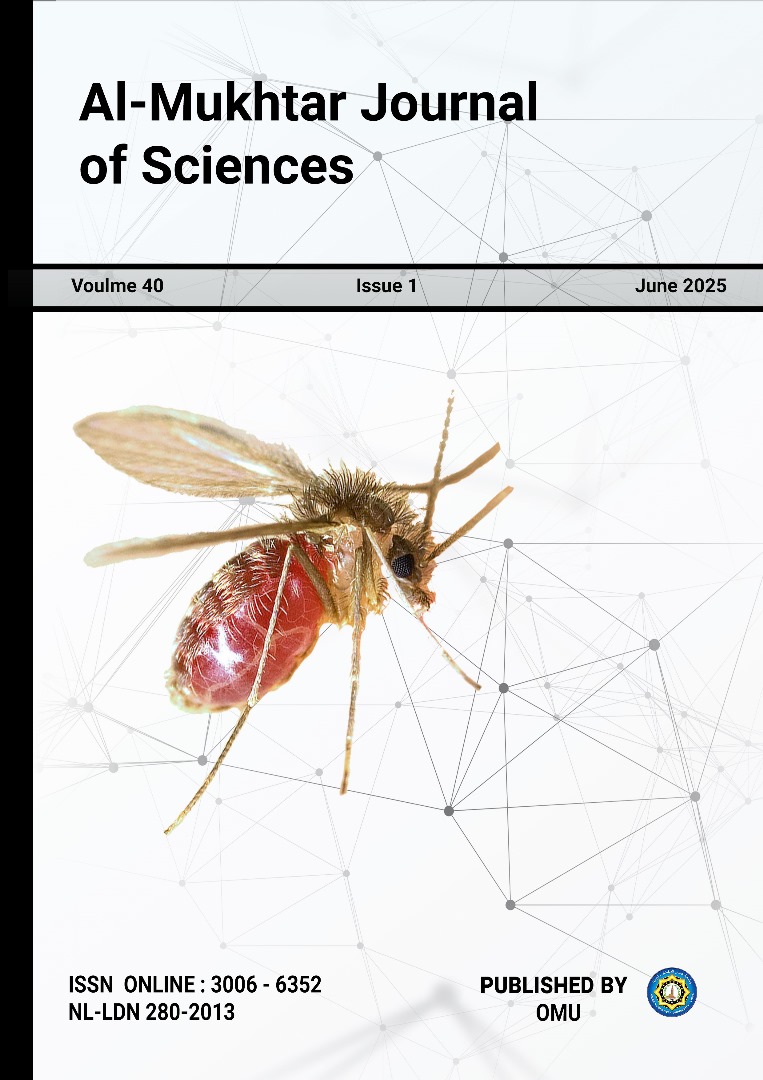An Epidemiological Study of Cutaneous Leishmaniasis in the Cities of Sirte and Jadu, Libya: During 2019-2020
- Authors
-
-
Kaula. A. Saad
Libyan Authority for Scientific Research, Tripoli, LibyaAuthor -
Hanan. A. Ageehal
Administration of Zoonotic Disease Control- National Centre of Diseases Control - Tripoli- LibyaAuthor -
Ahmed. S. Elgrari
Administration of Zoonotic Disease Control- National Centre of Diseases Control - Tripoli- LibyaAuthor
-
- Keywords:
- Epidemiology, Cutaneous leishmaniasis, Sand fly, Parasite, Pentostam, Sirte, Jadu
- Abstract
-
Cutaneous leishmaniasis CL is a complex clinical syndrome caused by transmitting an intracellular parasite to humans through sand fly bites. Libya is one of the countries endemic to CL. The goal of this study is to study the epidemiological aspects of CL from 2019 to 2020 in Sirte and Jadu. Demographic and epidemiological data for all patients were collected from health centers by the National Center for Disease Control in Libya. Descriptive statistics were used to describe the characteristics of the study data. A total of 355 people with CL were identified. 143 CL-positive cases in Jadu and 212 in Sirte. The highest prevalence of affected age groups was found among patients aged 10 to 19 (17 %). The peak incidence of the disease occurred in the autumn. The most common locations of lesions were the legs and hands. Treatment was mentioned only in 30 % of registered cases. CL remains a health problem with medical and social consequences in the cities of Sirte and Jadu. To minimize the risk of disease, it is highly recommended to manage reservoir hosts and disease vectors, as well as provide education on personal protection measures.
- Downloads
-
Download data is not yet available.
- References
-
Mostafa, E., Ghasemian, A., Abdinasir, A., Nematollahi Mahani, S. A., Rawaf, S., Salehi Vaziri, M., & et al. (2021). Emerging and re-emerging infectous diseases in the WHO eastern Mediterranean region, 2001–2018. Int J Heal Policy Manag, 11:1286–300.
Organization WHO. (2014). Manual for case management of cutaneous leishmaniasis in the WHO Eastern Mediterranean Region. WHO Regional Publications. 2014. Retrieved from https://www.who.int/publications/i/item/9789290219453
Olias-Molero, A. I., de la Fuente, C., Cuquerella, M., Torrado, J. J., & Alunda, J. M.(2021). An-ileishmanial Drug Discovery and Development. Time to Reset.the.Model Microorganisms. 2021; 9:2500.
Mandell Douglas & Bennett’s. (2005). principles and Practice of infectious diseases. In G.L. Man-dell, J.E. Bennett, R. Dolin (Eds) . 6th ed. Elsevier
Doha, S. A., & Samy, A. M. (2010). Bionomics of phlebotomine sand flies (diptera Psychodidae) in the province of Al-Baha. Saudi Arabia Mem. Inst. Oswaldo Cruz. 105, 850–856.
Lupi, B. L, Bartlett, R.N., Haugen, L.C., Sethi, S. N., Klaus, & et al. (2009). Tropical dermatolo-gy: tropical diseases caused by protozoa. J Am Acad Dermatol., 60; pp. 897-928.
Kevric, M. A., Cappel, J. H., & Keeling. (2015). New World and Old World Leishmania Infec-tions. A Practical Review Dermatol Clin., 33; pp. 579–5931.
Jain, S., El Mangoush, M. A., El-Bouri, K., & Mahfouz, M. O. (1990). Kala azar in an adult Libyan and review of visceral leishmaniasis in Libya. Tropical and geographical medicine. Jul1; 42(3): 283-5
Boelaert, M., El-Safi, S., Hailu, A., Mukhtar, M., Rijal, S., Sundar, S., Wasunna, M., Aseffa, A., Mbui, J., Menten, J., & et al. (2008). Diagnostic tests for kala-azar: A multi-centre study of the freeze-dried DAT, rK39 strip test and KAtex in East Africa and the Indian subcontinent. Trans. R. Soc. Trop. Med. Hyg. 102, 32–40.
Gonzalez, U., Pinart, M., Reveiz, L., & Alvar, J. (2008). Intervention for Old World cutaneous leishmaniasis. Cochrane Database Syst Rev Oct 8; (4) :CD005067. PMID:18843677.
Aoun, K., & Bouratbine, A. (2014). Cutaneous leishmaniasis in North Africa: a review Parasite 2014; 21:1–9.
Ashford, R. W., Chance, M. L., Ebert, F., Schnur, L. F., Bushwereb, A. K., & Drebi, S. M. (1976). Cutaneous leishmaniasis in the Libyan Arab Republic: distribution of the disease and identi-ty of the parasite. Ann Trop Med Parasitol, 70:401–409.
Amro, A., Gashout, A., Al-Dwibe, H., Zahangir Alam, M., Annajar, B., Hamarsheh, O.,& et al. (2012). First molecular epidemiological study of cutaneous leishmaniasis Libya. PLoS Negl Trop Dis, 6:e1700.
Aoun, K., Bousslimi, N., Haouas, N., Babba, H., El-Buni, A., & et al. (2006). First report of Leish-mania (L) killicki Rioux, Lanotte & Pratlong, 1986 in Libya. Parasite. 13: 87–88. PMID: 16605075.
Fathy, F. M, El-Kasah, F.,& El-Ahwal, A. M. (2009). Emerging cutaneous leishmaniasis in Sirte-Libya: epidemiology, recognition and management. J Egypt Soc Parasitol, 39:881–905.
Abdellatif, M. Z., El-Mabrouk, K., & Ewis, A. A. (2013). An epidemiological study of cutaneous leishmaniasis in Al-Jabal Al-Gharbi, Libya. Korean J Parasitol. 51:75–84
Ashford, R. W., Schnur, L. F., Chance, M. L., Samaan, S .A., & Ahmed ,H .N. (1977). Cutaneous leishmaniasis in the Libyan Arab Republic: preliminary ecological findings. Ann Trop Med Parasitol, 71:265–271.
El-Buni, A., Taleb, I., Ben-Darif, A., Refai, A., Al-Edodi, K., Tawall, A., & et al. (1993). Leish-maniasis in Libya and studies on sand flies. Arch Inst Pasteur, Tunis. 70:40–409.
Kadiki, O., & Ashraf, M A. (1971). Cutaneous leishmaniasis in the Libyan Arab Republic Mimeo. Ministry of Health, Tripoli, Libya. the national control program of leishmaniasis in Libya
AboAssara, A., Buishi, I., Fares, A., Gusbi, M., & Annajar, B. (2015). Retrospective Study for Cu-taneous Leishmaniasis in Jadu Area, Libya Libyan J. Vet. Med. Sci. Vol. 1 (1): 24-32.
Elammari, N., Elhadar, J., & Annajar, B. (2008). Trends in Zoonotic Cutaneous Leishmaniasis (ZCL) in Eight EndemicMunicipalities of North-West Libya During 2004 – 2008. G.J.B.A.H.S.,Vol.4(4):1-6, ISSN: 2319 – 5584.
El-Buni, A.A., Jabeal, I., & Ben-Darif, A. T. (2000). Cutaneous leishmaniasis in the Libyan Arab Jamahiriya: a study of the Yafran area. East Mediterr Health J. 6, 884 -887.
Roberts, C.W., Walker, W,, & Alexander, J. (2001). Sex-associated hormones and immunity to protozoan parasites. Clin Micobiol Rev. 14: 476-88.
Mendonça, S. C. (2016). Differences in immune responses against Leishmania induced by infection and by immunization with killed parasite antigen: implications for vaccine discovery. Para-site Vectors. 9: 492.
Bounoua, L., Kahime, K., Houti, L., Blakey, T., Ebi, L., Zhang, P., & et al. (2013). Linking Climate to Incidence of Zoonotic Cutaneous Leishmaniasis (L. major in Pre-Saharan North Africa. Int J Environ Res Public Health. 10. 3191-3172.
Faraj, C., Adlaoui, E., Ouahabi, S., El Kohli, M., El Rhazi, M., Lhoussine, L., & et al. (2013). Dis-tribution and bionomic of san flies in five ecologically different cutaneous leishmaniasis focci in Morocco. ISRN Epidemiol. 2013 ; 1-8.
Alsamarai, A. M., & Al obaidi, H. S. (2009). Cutaneous leishmaniasis. in Iraq. Journal of Infection in Developing Countries.2009; 3: 123–129
Groge, M., Hickman, M., Ellis, W., Hudson, T., Lazo, J., Sharlow, ER., & et al. (2013). Drug dis-covery algorithm for cutaneous leishmaniasis. Am J Trop Med Hyg, 88: 216-222
Abdellatif, M. Z., El-Mabrouk, K., & Ewis, A. A. (2013). An epidemiological study of cutaneous leishmaniasis in Al-jabal Al-gharbi, Libya. Korean J Parasitol. 51: 75-84
Mosleh, I. M., Geith, E., Natsheh, L., Schonian, G., Abotten, N., & Kharabsheh, S. (2008). Effica-cy of cryotherapy regimen to treat Leishmania major cutaneous leishmaniasis. J Am Acad Dermatol. 58: 617-624.
- Downloads
- Published
- 2025-08-03
- Issue
- Vol. 40 No. 1 (2025)
- Section
- Articles
- License
-
Copyright (c) 2025 Kaula. A. Saad, Hanan. A. Ageehal, Ahmed. S. Elgrari (Author)

This work is licensed under a Creative Commons Attribution-NonCommercial 4.0 International License.
Copyright of the articles Published by Almukhtar Journal of Science (MJSc) is retained by the author(s), who grant MJSc a license to publish the article. Authors also grant any third party the right to use the article freely as long as its integrity is maintained and its original authors and cite MJSc as the original publisher. Also, they accept the article remains published by the MJSc website (except in the occasion of a retraction of the article).
How to Cite
Similar Articles
- Manal H. Algraiw, Huda H . Algriw, Omar I. Abusnena, Combatting Fatigue and Bone Pain: The Impact of Vitamin D Treatment in the General Practice Setting , Al-Mukhtar Journal of Sciences: Vol. 40 No. 1 (2025)
- Fathy A. Abdolmejed , The Visual Outcome of Gunshot Injury after Last Civil War in Tobruk-Libya: A Retrospective Study , Al-Mukhtar Journal of Sciences: Vol. 39 No. 2 (2024)
- Jebril S. Elabidi, Asmaa F. Salih, Monia F. Abusarayi, Epidemiological and Clinical Characteristics of Pediatric Urinary Tract Infections in Benghazi, Libya: A Two-Year Retrospective Study , Al-Mukhtar Journal of Sciences: Vol. 40 No. 1 (2025)
- Naseralla J. Elsaadi Suliman, Sara I. El Fallah, Factors Influencing Postoperative Hospital Stay Following Colorectal Cancer Resection , Al-Mukhtar Journal of Sciences: Vol. 38 No. 3 (2023)
You may also start an advanced similarity search for this article.

















